This article was updated in July 17, 2025 with new products and information by Mark S. Taylor
Picture this: you’re late for work, you turn the key in your 2007 Toyota Corolla, and all you hear is a loud click . That was me not too long ago — stranded in the driveway, convinced I had a broken starter. After a few deep breaths and a helpful friend, it turned out to be dirty battery terminals, but I’ve since faced a real starter problem and lived to tell the tale. If you’re wondering how to fix a broken starter — or even just test if it’s the issue — I’ve been there, done that, and got the tools and know-how to prove it. In this guide, I’ll walk you through what I learned the hard (but cheap) way — from checking the basics to replacing the whole unit, so you can get back on the road without breaking the bank.
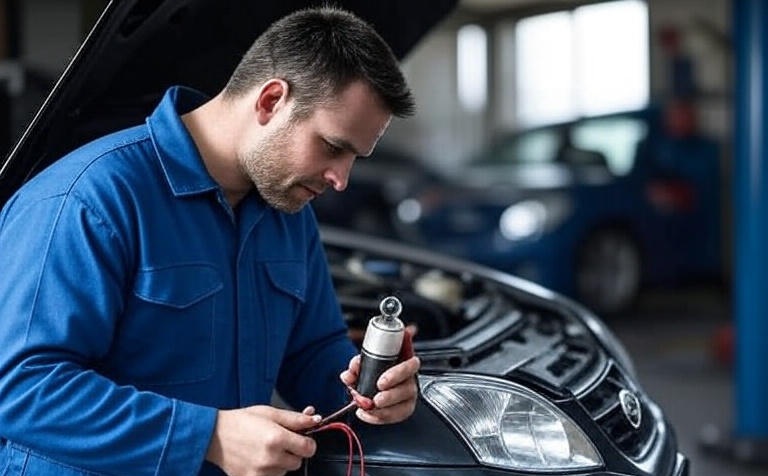
Contents
How Do I Know If My Starter Is Broken?
You turn the key, and all you hear is a click . No rumble, no start — just silence. That’s exactly what happened to me one morning with my 2007 Toyota Corolla. At first, I was convinced I had a broken starter. But after a little digging (and a friend who knows his way around cars), I found out it was just dirty battery terminals. Still, I’ve been through enough to know what a real starter problem feels like — and how to tell the difference.
If your car makes a single loud click when you turn the key, that’s often the starter trying — and failing — to kick in. If it’s a rapid click-click-click , it’s more likely your battery is dead. In my case, I even heard a grinding noise for a couple of days before it gave up completely. It’s like your car’s cry for help — and if you ignore it, you might end up stuck.
Here’s how I check if it’s really the starter:
First, test the battery with a multimeter. You want at least 12.2 volts. If it’s lower, charge it up. If it still won’t start, bring it to a parts store — they’ll test your cold cranking amps for free. That’s what I did, and it saved me from replacing a good battery.
Next, check the basics. Make sure your car is in Park (or Neutral if it’s a manual), and test the anti-theft light on the dash. If it blinks or stays on, your key chip might not be recognized. And don’t skip the starter relay and fuse — swap the relay with another one to test it. If the car still won’t start, try the old-school trick: tap the starter with a hammer while someone turns the key. If it kicks on, that’s a clear sign the starter’s gone bad.
What surprised me most was how often it’s not the starter. AutoZone told me that around 70% of no-start issues come from the battery or connections — not the starter. But when you’ve ruled out everything else and that click still won’t quit, you’ve probably got a faulty starter or solenoid on your hands.
Bottom line: listen to what your car is telling you. The sounds it makes (or doesn’t make) can guide you straight to the problem — and save you time, money, and a whole lot of frustration.
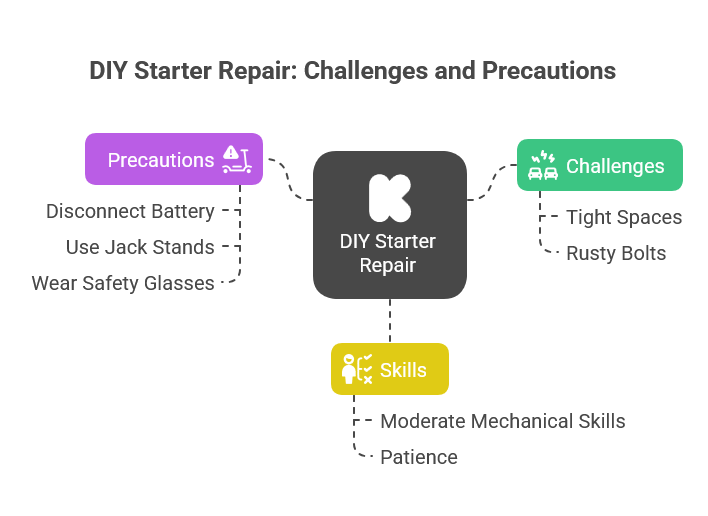
Can a Bad Starter Be Repaired, or Should You Replace It?
Here’s the thing — not every bad starter needs a full replacement. I learned this the hard way after driving my truck through water (didn’t think it was that deep!). When it wouldn’t start later, I was ready to buy a new starter — until I found out I could just replace the contacts for about $30. That’s right — sometimes, a simple fix is all you need.
If your starter is making that annoying clicking sound or acting up every now and then, it might just be the contacts inside the solenoid wearing out. Replacing them is totally doable if you’ve got some basic tools and a little patience. I tried it myself and, sure, it was a bit of a pain in tight spaces — especially with rusted bolts. But with a little WD-40 and some elbow grease, I got it done without spending hundreds.
But here’s the catch: if your starter motor is fried, the solenoid is busted, or you snapped a post trying to loosen a stuck bolt (which I almost did!), it’s smarter to just get a new one. Same goes if your starter got soaked or has serious corrosion — trust me, I’ve been there. Water damage can mess things up bad, and you don’t want to risk being stranded again.
So how do you know which way to go? Take your starter to a parts store like AutoZone — they’ll test it for free and tell you if it’s worth fixing or better off replaced. That’s exactly what I did, and it saved me time, money, and second-guessing my own work.
In short: repair if the motor and solenoid are still good, replace if things are burned out or broken beyond fixing. Either way, don’t jump to the most expensive option — check your options first. That’s how you fix a broken starter without breaking the bank.
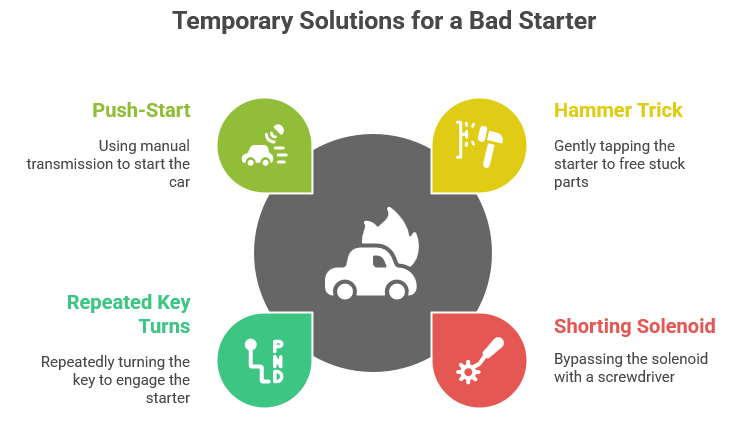
Can You Fix a Starter on Your Own?
Let me cut to the chase — yes, you can fix a starter on your own , even if you’re not a mechanic. I did it the first time with nothing but a few basic tools, a YouTube video, and a little help from a friend who knew his way around cars. If I could do it, so can you — especially if you’ve ever changed a battery or replaced a headlight before.
It’s not always easy, though. I learned that the hard way when I had to replace the starter contacts on my truck after driving through a lake (yeah, bad idea). The starter was tucked up near the engine and transmission, and those bolts were so tight and rusty I thought I’d never get them out. But with some WD-40, a U-joint, and a little patience, I got it done. And honestly, the biggest hurdles were the tight spaces and rust — not the actual repair.
You don’t need to be a pro, but you do need moderate mechanical skills and the right mindset. If you’ve ever worked under the hood before — like swapping out a battery or replacing a belt — you’re already halfway there. Just take your time, follow a good guide (like this one), and don’t rush the job. Oh, and don’t forget to disconnect the negative battery terminal first — that’s not just a suggestion. That wire going to the starter carries serious power, and trust me, you don’t want to short it out.
And if you’re working under the car, safety is everything . I always use jack stands and double-check that my truck is stable before crawling under. It only takes one slip to turn a simple repair into a nightmare. I also wear safety glasses — tiny bits of rust and debris love to fall right into your eyes when you’re upside down in the engine bay.
So, can you fix a starter yourself? Absolutely. Just be ready for a few challenges, take the right precautions, and don’t be afraid to ask for help when you need it. This is one of those jobs that feels like a big win once it’s done — and you’ll save a bunch of cash while feeling like a total car hero.
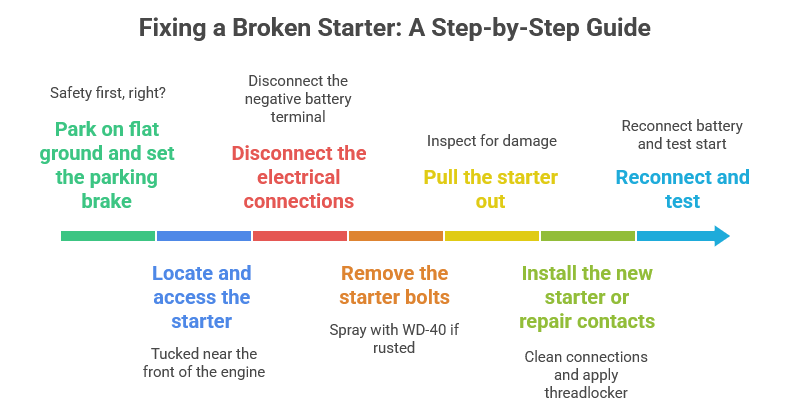
How to Fix a Broken Starter: A Step-by-Step Guide
So, you’ve confirmed it — your starter’s bad. Don’t panic. I’ve been there, covered in grease and wondering why I didn’t just take it to a shop. But the truth is, fixing a broken starter isn’t as bad as it sounds. With the right tools, a bit of patience, and a few smart tricks I’ve picked up along the way, you can get your car running again — and save a bunch of cash while you’re at it.
Let’s walk through the process step-by-step, based on what I’ve done myself and what I’ve seen work best in real life — like when I had to replace the contacts in my truck after driving through a lake (bad idea, but great learning experience).
Step 1: Get Your Car and Tools Ready
First things first — park on flat ground and set the parking brake . Safety first, right? Chock the wheels if you’re extra cautious like I am.
Now grab your tools:
- Socket set (10mm, 12mm, 14mm)
- Swivel-head ratchet and universal joint (tight spaces are real)
- Torque wrench
- WD-40 (for rusted bolts — trust me)
- Silicone paste (to prevent corrosion)
- Sandpaper (200-grit works great)
- Safety glasses (because debris loves your eyes)
Pro tip: Keep a rag nearby. I’ve lost more than one bolt in the engine bay, and a quick swipe with a cloth saved my sanity.
Step 2: Locate and Access the Starter
On a 2007 Toyota Corolla (and most cars like it), the starter is tucked near the front of the engine, right where the engine and transmission meet. It’s not easy to reach — especially if, like me, you drove through water and rusted everything in place.
You’ll likely need to jack up the vehicle and secure it with jack stands . I always double-check stability before crawling under — better safe than crushed.
In some cases, like mine, you might need to remove an exhaust mount or other parts to get access. It’s a bit of a pain, but once you’ve got a clear path, you’re golden.
Step 3: Disconnect the Electrical Connections
Before doing anything electrical, disconnect the negative battery terminal . That starter wire carries a lot of power — you don’t want to short anything out.
Next, remove the wires connected to the starter. Most use 10mm or 12mm nuts — keep track of where they go. If you see corrosion, grab that sandpaper and clean the posts. I had to do this when my battery terminals were gunked up — and it made a world of difference.
And here’s a trick I learned the hard way: apply silicone paste to the connections before reattaching. It helps prevent corrosion — especially if your car’s been in water like mine.
Step 4: Remove the Starter Bolts
Most starters are held in by 2–3 bolts , usually 14mm on a Corolla. Use that swivel ratchet or universal joint — you’ll thank me later.
If the bolts are rusted (like mine were), spray them with WD-40 and let it sit for 10 minutes. It’ll save your knuckles and your sanity.
And here’s a pro move: hold the starter when removing the last bolt . It’s heavier than it looks — and dropping it while under the car is no fun.
Step 5: Pull the Starter Out
Now comes the fun part — wiggling the starter out . In a Corolla, space is tight. Be patient and take your time.
Once it’s out, inspect it for damage . If the mount is cracked or the gears are worn, it’s definitely time for a new one. If you’re unsure, take it to a parts store — most, like AutoZone, will test it for free.
Step 6: Install the New Starter (or Fix the Contacts)
You’ve got two options here:
Option 1: Install a New Starter
- Clean the wire connections with sandpaper.
- Line up the new starter and apply threadlocker to the bolts.
- Torque them to about 20 ft-lbs — don’t over-tighten.
- Reconnect the wires and add silicone paste to protect against corrosion.
Option 2: Repair the Contacts
- Remove the solenoid cover (usually 7mm bolts).
- Replace the worn contacts, making sure to note the order of grommets, washers, and other small parts.
- Reassemble and reinstall.
I did this on my truck to save money — but it’s fiddly. Make sure whoever’s helping you is comfortable working with small parts.
Step 7: Reconnect and Test
Once the new or repaired starter is in, reconnect the wires — double-check their positions. Apply a bit more silicone paste if your car’s been in water.
Reconnect the negative battery terminal , lower the car, and give it a try.
If everything worked like it did for me, you’ll hear that satisfying click turn into a smooth engine start — and you’ll feel like a total car hero.
Bottom line: Fixing a broken starter is totally doable at home. Whether you replace the whole unit or just the contacts, the key is taking your time, using the right tools, and cleaning those connections. And if you’ve got a friend who knows what they’re doing, even better — because a little help goes a long way when you’re under the hood.
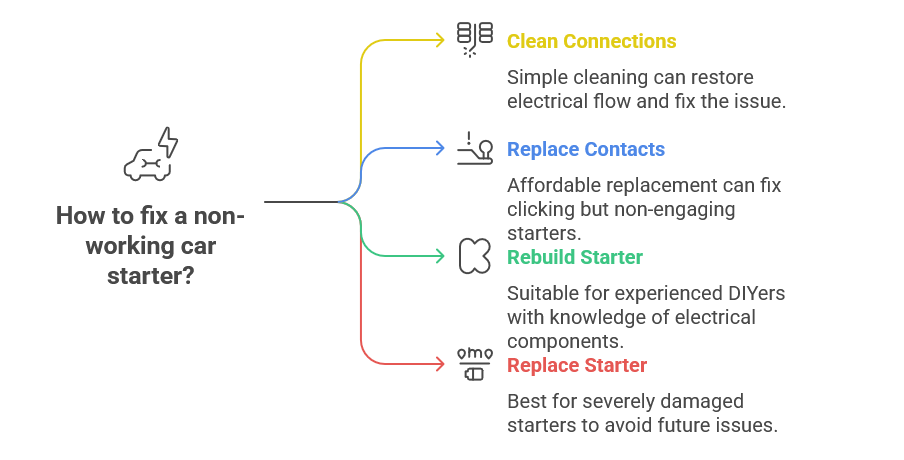
How Can I Start My Car with a Bad Starter?
Let’s say you’re stuck — you turn the key, and all you hear is a click . No rumble, no startup, no good. If you’re dealing with a bad starter, I’ve been there, and I’ve tried just about every trick in the book. While it’s not a long-term fix, there are a few things you can try to get your car running and get you home — or at least to the nearest garage.
One trick that actually works — and I’ve used it myself — is the hammer trick . Have someone turn the key while you gently tap the starter with a hammer or metal rod. I know it sounds sketchy, but sometimes the vibration can free up a stuck solenoid or worn-out contacts. In my case, it got my friend’s truck running just long enough to make it to a shop. But don’t go full carpenter on it — a few light taps are all it takes.
Another method is shorting the solenoid with a screwdriver. This bypasses the solenoid and sends power straight to the starter. It’s a bit more advanced and comes with some risk (like sparks or electrical issues), so if you’re not comfortable messing with live wires, skip this one or get help from someone who knows what they’re doing.
Sometimes, just turning the key a few times in a row can coax the starter into working — at least for a second. The idea is that repeated attempts might generate enough heat or movement to get it to engage. Just be careful — if you smell anything burning, stop right away. That’s your starter telling you it’s done.
And if you drive a manual transmission , you’re in luck — you can push-start your car. Put it in second gear, push it until it rolls, then pop the clutch. That should kick the engine over. Unfortunately, if you’re in an automatic like my Corolla, this won’t work — so you’ll have to rely on the other tricks.
But here’s the real talk: these are temporary fixes . I can’t stress that enough. They’re just enough to get you rolling, but not a real solution. A bad starter is going to leave you stranded again if you don’t fix or replace it soon.
So if you try one of these tricks and it works — great! But don’t keep driving around hoping it’ll hold. Head to a mechanic or tackle the fix yourself before you’re stuck in a parking lot or worse — on the side of a busy road.
Bottom line: You can get your car started with a bad starter — but don’t treat it like a long-term plan. Use one of these tricks to get moving, but make fixing the starter a priority. Your future self (and your driveway) will thank you.
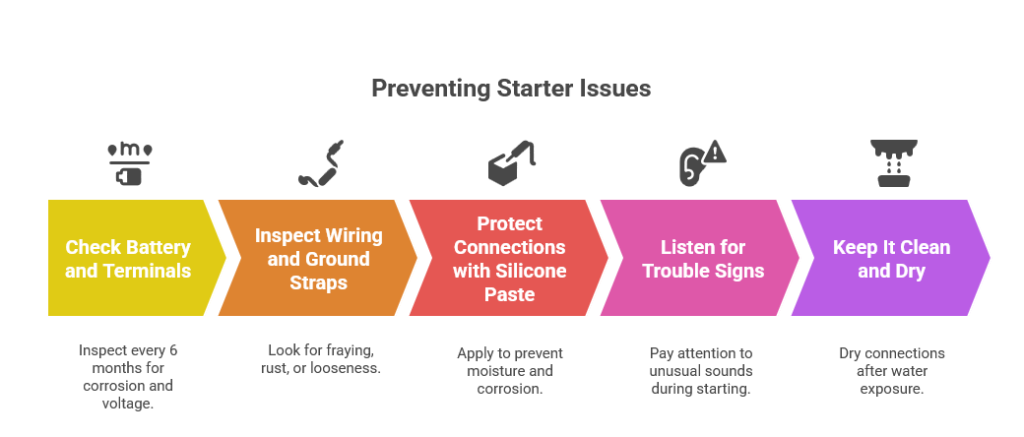
How Can I Make My Starter Work Again?
Here’s the good news: sometimes, your starter isn’t completely shot — it just needs a little love. I learned this the hard way (and with a little help from my friend). At first, I thought I had a full-on starter failure, but after cleaning the battery terminals — boom — it fired right up. So before you dive into expensive repairs or replacements, try these fixes that can make your starter work again .
Clean Those Connections
This one’s a game-changer. Corrosion on your battery or starter terminals can mimic a bad starter by blocking the electrical flow. It’s exactly what happened to my Corolla — I thought it was toast, but all it needed was a little cleaning.
Grab some sandpaper or a wire brush , and scrub both the battery posts and the inside of the terminals. It only takes a small amount of corrosion to mess things up. After cleaning, I got full power back — and a free fix to boot.
Replace the Contacts
If your starter clicks but doesn’t engage, it might be the worn contacts inside the solenoid . This is super common, and the fix is affordable — I replaced mine for about $30. If the motor and solenoid are still good, swapping the contacts can bring your starter back to life.
I did this myself after my lake incident (yes, that was a great idea), and it worked like a charm. Just be careful — there are a bunch of small parts, and order matters when you’re putting it back together.
Try a Rebuild Kit (If You’re Skilled)
Some starters can be rebuilt with new brushes, bearings, or solenoids , especially in older vehicles. But this is a job for someone with experience — it’s fiddly and requires a good understanding of how the starter works internally.
I’ve seen people do it successfully, but if you’re not confident working with small electrical components, it might not be worth the headache. For most DIYers, replacing the whole unit or just the contacts is the smarter move.
Know When to Replace It
If your starter motor is burnt out, the solenoid is fried, or water damage has done a number on it (like mine), it’s best to just replace the whole thing. Trying to fix a severely damaged starter is like putting a band-aid on a broken leg — it won’t hold long.
I took mine to AutoZone for testing, and they confirmed it was on its way out. If you’ve got a unit that’s been soaked or has serious wear, skip the patch jobs and go for a new starter. It’ll save you from being stranded again.
Final Word of Advice
Always double-check the basics before tearing into your starter. Clean connections, test the battery, and confirm the issue is actually the starter — not something simpler. I thought mine was toast, but a little cleaning and a $30 contact swap did the trick.
So if your car won’t start, don’t panic. Start simple, work your way up, and remember — sometimes the fix is easier (and cheaper) than you think.
Tips to Prevent Future Starter Issues
Let’s be real — dealing with a broken starter is a pain. I’ve been there, stranded in a driveway, convinced my truck was done for. But the good news? A lot of starter issues can be avoided with a little regular care. If you take care of your car’s electrical system — especially if you’ve had water exposure like I did — you can keep your starter running strong for years.
Here are the best tips I’ve picked up from my own experiences and from working on cars over the years:
Keep an Eye on Your Battery and Terminals
I can’t stress this enough: check your battery and terminals every 6 months . Corrosion builds up faster than you think — especially if you drive through water or live in a humid area. After my lake incident (yes, that was a great idea), I learned just how much damage moisture can do.
Use a multimeter to check voltage — you want to see 12.2V or higher . If it’s lower, charge it up. And don’t forget to clean those terminals with a wire brush or sandpaper. A little maintenance now can save you from a no-start situation later.
Inspect the Wiring and Ground Straps
The starter doesn’t work alone — it relies on solid wiring and a good ground connection. Over time, wires can wear out, connections can loosen, and water can sneak in.
I’ve had to replace ground straps after they corroded from moisture. It’s a small part, but a broken ground can mimic a bad starter. So every so often, check the wiring around your starter and battery for fraying, rust, or looseness. If something looks off, fix it before it leaves you stranded.
Protect Your Connections with Silicone Paste
This is one I learned the hard way. After dealing with repeated corrosion, I picked up a tip from a parts store guy: use silicone paste or dielectric grease on your electrical connections.
It works like magic. It keeps moisture out and prevents corrosion from forming on the posts and wires. Just a small dab on the battery terminals and starter connections can go a long way in keeping your system running smoothly.
Listen for Trouble Signs
Your car usually gives you a heads-up before the starter dies completely. Maybe it clicks when you turn the key. Maybe it grinds a little before turning over. These are red flags.
I ignored a grinding noise for days before my starter finally gave up. If I’d acted sooner, I might have just needed a simple fix instead of a full replacement.
So, listen to your car . If you hear unusual sounds when starting, don’t wait — check it out before it becomes a bigger issue.
Keep It Clean and Dry
Water is a sneaky enemy. Whether it’s from driving through puddles, pressure washing your engine, or yes, driving through a lake (don’t ask), moisture can wreak havoc on your starter and wiring.
If your car’s been submerged or exposed to heavy rain, dry out the connections and apply silicone paste as soon as possible. It’s a small step that can extend your starter’s life by up to two years , according to automotive studies.
Final Word
Preventing starter issues isn’t rocket science — it’s just about being proactive. Check your battery, clean your connections, and pay attention to what your car is telling you. A few minutes of maintenance every few months can save you hours of frustration down the road.
And trust me — from someone who’s been stuck in the driveway more than once — it’s worth the small effort to avoid that dreaded click when you turn the key.
FAQs About Fixing a Broken Starter
Can you fix a starter on your own?
Yes, with basic tools and some mechanical skill. You can replace contacts (~$30) or the whole starter (~$100–$150). It’s doable if you’ve done car work before.
How can I start my car with a bad starter?
Try tapping the starter with a hammer while someone turns the key. You can also short the solenoid or push-start a manual car. These are temporary fixes — replace the starter soon.
Can a bad starter be repaired?
Yes, if the issue is worn contacts or dirty connections. Replace contacts (~$30) or clean terminals. If the motor or solenoid is broken, you’ll need a new starter.
How much does it cost to fix a broken starter?
Fixing contacts costs about $30. A new starter is $100–$150. Shops may charge $200–$400 total for parts and labor. DIY saves money if you’ve got the tools.
How long does it take to replace a starter?
Most DIY jobs take 1–2 hours. Some cars have tight spaces or rusty bolts, which can add time. Shops usually finish in 1–3 hours, depending on access and skill level.
My Final Thoughts on about Fixing a Broken Starter
If you’re someone who loves fixing car issues on your own and values saving money while learning new skills, this guide is for you . But if you’re not comfortable with tools or prefer quick fixes, a shop might be your best bet.
I’ve been in the driveway, stuck with a broken starter, thinking I needed a full replacement — until I learned to check the basics first. Cleaning terminals, tapping the starter with a hammer, and using WD-40 on rusted bolts saved me time and cash. It’s not magic — it’s just knowing where to start.
Fixing a broken starter is totally doable, especially if you’ve got a little patience and the right tools. And if you ever get stuck (literally or figuratively), just remember — I’ve been there, and I’m here to help you through it.
Got a car story or a starter fix that worked for you? Drop it in the comments — I’d love to hear it. And if you found this helpful, hit subscribe for more real-talk DIY guides that’ll keep you rolling.
